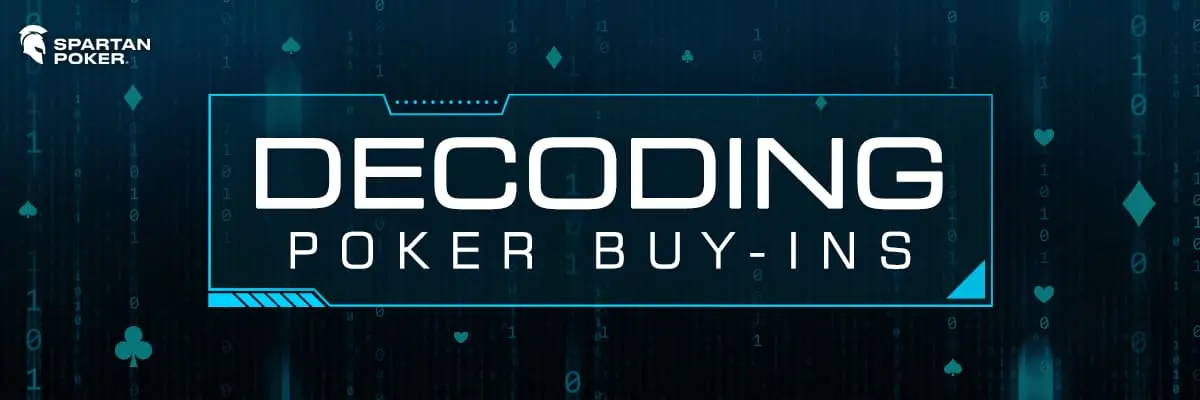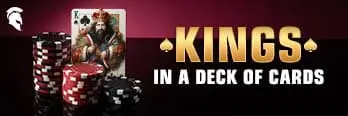In the world of poker, a buy-in is the first outlay of funds needed to enter a game or tournament; it's the entry point to possible winnings and strategic gameplay.
Understanding the ins and outs of buy-in dynamics is essential for any player hoping to succeed in the poker world, whether they are playing cash games or tournaments.
This article explores the nuances of buy-ins in poker and offers a framework for understanding their importance and making the best decisions in tournament and cash game situations.
Definition of a Poker Buy-In
In poker, the amount of money needed to enter a game or tournament is referred to as the buy-in. The buy-in amount varies based on the particular game structure, stakes, and rules of the poker variant being played, but it basically acts as a ticket to participate in the action.
The buy-in usually determines the possible prizes for players based on their performance and adds to the prize pool in tournaments.
On the other hand, in cash games, a player's ability to weather game swings and seize lucrative opportunities is directly impacted by the buy-in, which also determines how many chips they get to use at the table.
Understanding Buy-ins for Cash Games and Tournaments
Poker players need to understand buy-ins since they have a direct impact on their entire strategy, bankroll management, and possible returns on investment. A player's choice of which events to enter in a tournament frequently depends on elements including the buy-in amount, the distribution of the prize pool, and their own skill level in comparison to the field.
Understanding add-ons and rebuys, which are sometimes offered in particular events, also highlights how important buy-ins are in determining a player's strategy for optimizing longevity and profitability in the event.
Similar to this, the buy-in is a key component of sound bankroll management in cash games. To reduce the chance of suffering significant losses, players must carefully consider the stakes and buy-in quantities that correspond with their skill level and financial capabilities.
Furthermore, by comprehending the dynamics of buy-ins in cash games, players can modify their tactics in response to various elements, including the dynamics of the table, the playing styles of their opponents, and the ideal chip stack sizes for capitalizing on lucrative possibilities.
Understanding Buy-ins in Poker Tournaments
1. Definition of tournament buy-in
The amount of money needed to enter a real money poker event and receive a starting stack of chips is referred to as the "buy-in" in this context. The degree of competitiveness, the size of the prize fund, and the possible return on investment for players are usually determined by the buy-in amount.
2. Explanation of how tournament buy-ins vary in amount
The buy-ins for tournaments can differ greatly; they might be as little as a few dollars for low-stakes events or as much as hundreds or even tens of thousands of dollars for high-stakes competitions.
The range of buy-ins accommodates players with varying bankroll sizes, tastes, and skill levels, reflecting the diversity of the poker community.
Different tournament formats with different buy-ins
There are several different kinds of tournaments, and each has its own structure and buy-in regulations:
1. Freezeout Tournaments:
Once a player runs out of chips, they are not able to add more or rebuy them. To participate, you only need to make the initial buy-in.
2. Rebuy tournaments:
After being eliminated, players can buy more poker chips or reenter the event, usually within a set amount of time or until a certain level is attained.
Because each participant may purchase numerous buy-ins, rebuy tournaments usually have larger buy-ins than freezeouts.
3. Satellite Tournaments:
In comparison to the main tournament they feed into, satellite tournaments have a reduced buy-in. Players can compete for greater rewards at a lower cost by winning a satellite that offers entry into a bigger, more prestigious event.
Also Read
Examining the ways in which tournament buy-ins affect the total prize money
The prize pool, which is split among the top players in accordance with the tournament payment schedule, is made up of the buy-ins that tournament participants have paid.
A tournament's prize pool grows with the number of participants, possibly leading to increased payments for those who place in the money. In larger events or those with guaranteed prize pools, tournament organizers may also add more money to the prize fund.
Importance of managing one's bankroll when considering tournament buy-ins
Effective bankroll management is essential in the world of tournament poker since it's the basis for durability and long-term success. It is impossible to exaggerate the significance of wise bankroll management since it gives players the confidence and fortitude to successfully negotiate the inherent risks and volatility of tournament play.
Players need to evaluate a number of aspects, such as their personal skill level, risk tolerance, and financial resources, before deciding on tournament buy-ins.
Through this evaluation process, players can choose a buy-in level that suits their goals and desires for poker in addition to being in line with their existing situation.
Through the use of a strict strategy for managing their bankroll, players can successfully reduce the possibility of incurring large losses that could potentially compromise their poker career.
By designating a specific percentage of their bankroll for tournament buy-ins, players can take part in events without risking their entire balance, protecting themselves from future financial losses.
Additionally, good bankroll management gives players a sense of security and assurance regarding their finances, which enables them to make logical, calculated choices as the competition heats up in a tournament.
Essentially, excellent bankroll management is essential to winning at tournament poker since it enables players to handle the intricacies of the game with caution, assurance, and foresight.
Players may maximize their tournament buy-in choices and set themselves up for long-term success in the competitive and dynamic world of tournament poker by carefully considering their financial situation, risk tolerance, and long-term objectives.
Examining Cash Game Buy-ins
When it comes to cash games, the buy-in is the amount that a player must deposit in order to join a table and be given a stack of chips to use.
In contrast to tournaments, where participants fight for a fixed prize pool, cash games allow players to risk real money on each hand and have the flexibility to get up from the table and pay out their chips whenever they choose.
Definition of buy-in for a cash game
The amount of money a player must trade for chips in order to join a cash game table is known as the "buy-in." The player's stack size and the stakes at which they can play the game are both determined by this first buy-in.
How Cash Game Buy-ins determine the amount of chips a player receives?
A player receives a stack of chips equal to the amount of money they have traded when they purchase into a cash game.
Throughout the duration of the game, these chips are utilized to put bets, call raises, and participate in hands as the player's currency at the table.
Minimum and Maximum buy-in amounts for Cash Games
To control player size and provide an even playing field, cash games usually have minimum and maximum buy-in limits. The maximum buy-in limits the most chips a player can bring to the table, while the minimum buy-in determines the least amount a player must exchange for chips to participate.
These limitations accommodate a range of player preferences and bankroll levels, and they change based on the particular game and location.
Differences between cash game and tournament buy-ins
A primary distinction between buy-ins for cash games and tournaments is found in the goals and structures of each. Cash game buy-ins decide how many chips a player receives to play with in a dynamic, continuous game, whereas tournament buy-ins contribute to a collective prize pool that is divided among top-performing players.
Furthermore, unlike tournaments with their set time and elimination-based structure, cash game buy-ins provide players with the freedom to join and quit the game whenever they want.
Strategies for managing one's bankroll effectively in cash games
Successful bankroll management is crucial in cash games since players are always at danger of making money on each hand.
To be able to tolerate fluctuation and reduce the chance of losing all their money, players should make an effort to keep their bankrolls large enough in relation to the stakes they are playing.
In order to lessen the effects of transient fluctuations, players should judiciously follow conservative buy-in criteria and restrict their buy-ins to a portion of their overall bankroll.
Furthermore, players can increase their profitability and endurance at the tables by practicing disciplined cash game play, which includes refraining from chasing losses and selecting wise games.
Factors to Consider When Choosing a Buy-in Amount
1. Bankroll Management Considerations
Bankroll management is one of the most important things to take into consideration when choosing a buy-in quantity in poker. This means determining how big your total bankroll is in relation to the stakes you plan to play at.
It is important to set aside a portion of your bankroll for playable stakes in order to reduce the possibility of large losses that could endanger your poker efforts.
Follow sensible bankroll management guidelines, such the "5% rule," which states that you should never commit more than 5% of your bankroll to a single buy-in, to ensure your long-term financial security.
2. Skill level and comfort level with the stakes
Your comfort level with the stakes and your degree of expertise are also important factors to take into account. Gamers ought to select buy-in amounts that correspond with their skill level and level of expertise.
Greater payouts may be the attraction of bigger stakes, but there is also more risk and competition. On the other hand, if you play at stakes that are too low for your skill level, you might not be able to take advantage of lucrative possibilities and you might not be able to improve as a player. Maximizing your chances of success requires striking the ideal balance between difficulty and viability.
3. Variance and risk Tolerance
Important components of buy-in selection include evaluating your risk tolerance and comprehending volatility. Variance is the term used to describe the natural swings in poker results, where even very good players can go through streaks of winning and losing.
Greater variance is usually associated with higher buy-in levels because of the more noticeable fluctuations in chip stacks and possible winnings or losses.
While players with a higher risk tolerance might be ready to take chances at bigger stakes in the hopes of earning larger winnings, those with a lower risk tolerance might choose to play for smaller buy-in amounts in an effort to lessen the impact of volatility on their bankroll.
4. Game format (cash game vs tournament)
Choosing between cash game and tournament formats also affects buy-in choices. Buy-ins add to the prize pool in tournaments, and successful players may receive a large return on their investment.
On the other hand, buy-ins are directly correlated with the quantity of chips you receive in cash games, which provide more instant benefits and the freedom to enter and depart at any time.
It is essential to comprehend the subtleties of each format and how buy-ins work within them in order to make well-informed decisions that suit your goals and tastes as a player.
What is "shot-taking" in poker?
The term "shot-taking" describes the habit of sometimes playing for higher stakes than normal in an effort to increase rewards or challenge one's abilities against more formidable opponents.
Shot-taking has inherent hazards even if it can be thrilling and financially rewarding. When it comes to shot-taking, players should proceed cautiously and make sure they have the necessary knowledge, expertise, and financial resources to handle the greater stakes' increased volatility and possible losses.
Strategic shot-taking, when done carefully and within the parameters of prudent bankroll management, may be a useful tool for pushing yourself, improving your abilities, and even speeding up your poker career.
Advanced Strategies Related to Poker Buy-ins
1. Concept of "buying the button" in cash games
"Buying the button" is a tactic utilized by players in poker cash games, especially in games like Texas Hold'em, to obtain a positional advantage. Using this strategy, you can sit in a late position without waiting for the dealer button to naturally rotate by posting an extra blind or ante.
By doing this, players essentially "buy" the button position, giving them the opportunity to act last after the flop and potentially gain important information and opportunities for calculated plays.
However, purchasing the button has additional costs, so players must assess if the move is worthwhile in light of their particular situation and the dynamics of the table by balancing the possible advantages against the higher outlay.
2. Importance of understanding the implied odds when deciding on a buy-in amount
The profitability of a poker hands is largely determined by implied odds, particularly in situations where players stand to win sizable pots should specific cards emerge on future streets.
Understanding implied odds is crucial when choosing a buy-in level for a tournament or cash game since it affects the possible return on investment.
In addition to the immediate chances of winning a hand, players should think about the possible future advantages in case they hit their desired cards and take advantage of their opponents.
Players can increase their chances of long-term success in poker by making better educated decisions about their buy-in quantities by taking implied odds into consideration.
3. Concept of "adding on" in tournaments
"Adding on" is a feature that's frequently seen in tournament poker. It lets players buy more chips at a predetermined break, which is usually the end of the rebuy phase. Add-ons are available to all players, regardless of chip count, in contrast to rebuys, which are only available to those who have lost their entire stack of chips.
With this option, competitors can increase their stack of chips and improve their chances of winning as the tournament goes on.
But players need to be careful when determining whether to add more, taking into account things like their current chip stack, the format of the tournament, and their strategic goals.
4. Adjusting buy-in strategies based on table dynamics and opponents
Advanced poker play is defined by the ability to modify buy-in strategies in response to changes in the table and the habits of opponents. When playing cash games, players might choose to increase their buy-ins in order to take advantage of advantageous table circumstances, such weak opponents or a great chance for profitable post-flop play.
On the other hand, in order to optimize the chance of obtaining a profitable return on investment, tournament organizers may need to modify their buy-in tactics by choosing events whose buy-ins correspond to the skill level and playing preferences of competitors.
Players can efficiently manage risks and take advantage of chances by refining their buy-in methods and staying adaptable to the subtleties of the game environment.
Bankroll Management Strategies for Professional Players
Sophisticated bankroll management techniques are crucial for professional poker players to maintain long-term success and sustainability in the game.
These techniques entail careful preparation, risk assessment, and backup plans to withstand the inevitable volatility of poker, and they go beyond just setting aside a percentage of one's bankroll for buy-ins.
Furthermore, playing a variety of cash games, tournaments, and satellite events can help diversify one's poker portfolio, minimizing risk and optimizing returns over time.
Professional poker players can successfully traverse the complicated poker landscape and position themselves for long-term success in the highly competitive world of professional poker by following rigorous bankroll management strategies.
Final Thoughts
A key component of poker are buy-ins, which open doors to exhilarating games, fierce competition, and the chase of prize pools that are highly sought after. Buy-ins are more than just a financial investment; they are a calculated move that conveys a player's dedication, aptitude, and goals in the poker world.
They force players to strike a balance between strategic goals and financial considerations in their pursuit of success, embodying the essence of risk and reward.
Furthermore, buy-ins are essential to the development of a thriving and dynamic poker environment because they draw players with varying bankroll sizes and skill levels to a wide range of games and tournaments.
Buy-ins offer the foundation for exciting, competitive play that crosses boundaries and connects poker aficionados all over the world, regardless of the player's skill level and preferences for casual amusement or elite competition.
Essentially, buy-ins are more than simply financial transactions; they signify the beginning of an exciting, challenging, and opportunity-filled world within the always changing poker scene.
Through comprehension of their importance, adoption of tactical methods, and proficiency in sophisticated strategies, players can leverage the influence of buy-ins to improve their performance, accomplish their objectives, and set off on remarkable adventures inside the colorful world of poker.

















